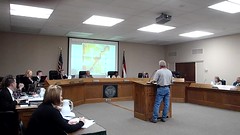
On May 12, the Valdosta Daily Times (VDT) published
Expansion No Go:
No additional commissioners this year.
About that, John S. Quarterman sent this letter to the editor (LTE) yesterday:
I see by the VDT that the current County Commission’s plan to expand
the commission by adding two super districts failed in the legislature
on a technicality. This pause provides useful time to see if there
might be a different strategy. It’s already 2010, and census data for
redistricting should be available in spring of next year. That will
take a lot of the guesswork out of redistricting.
While the voters said last year they were for commission expansion, it
is not clear that people actually favor super districts, since no other
option was on the ballot. Each current district has more people than
the total population of several nearby counties. This makes
commissioner elections needlessly expensive and less representative of
the variety within Lowndes County. It’s never been clear to me how
adding two larger districts solves that most basic problem, when there
are other options available.
Lowndes County could use more commissioners, and the current
Commission made a good try at that. Soon it will be the turn of a new
Commission to try again.

John S. Quarterman is running for County Commission, District 2.
The VDT responded:
The editor has reviewed your letter. She did not approve your letter
because as a candidate for office, we cannot run a letter to the editor
from you as it is considered campaigning and we would have to give
equal opportunities to the other candidates as well.
Indeed he is, see
www.JSQ4LCC.com.
And as readers of On the LAKE Front are aware, he is also one of the
founders of LAKE.
We understand the VDT has space constraints because it is primarily on paper.
However, LAKE is online, and
LAKE welcomes statements on this subject from any and all candidates.
Send them in, and LAKE will post them, just like this one.
Online, please: no paper, no fax.
So lengths will be comparable, please keep it to 250 words, like a VDT LTE.
Send a picture of yourself if you want to.
 The Glen Laurel Subdivision rezoning case that the Lowndes County
Board of Commissioners decided on Tuesday June 8 (REZ-2010-06)
raises all sorts of issues.
Let’s start by hearing Coy Brightwell (he lives just across Old Pine Road from
the proposed subdivision) summarize some points against
the rezoning, saying going all the way from RA to PD is too far,
and that the neighbors are asking for a compromise:
The Glen Laurel Subdivision rezoning case that the Lowndes County
Board of Commissioners decided on Tuesday June 8 (REZ-2010-06)
raises all sorts of issues.
Let’s start by hearing Coy Brightwell (he lives just across Old Pine Road from
the proposed subdivision) summarize some points against
the rezoning, saying going all the way from RA to PD is too far,
and that the neighbors are asking for a compromise:







